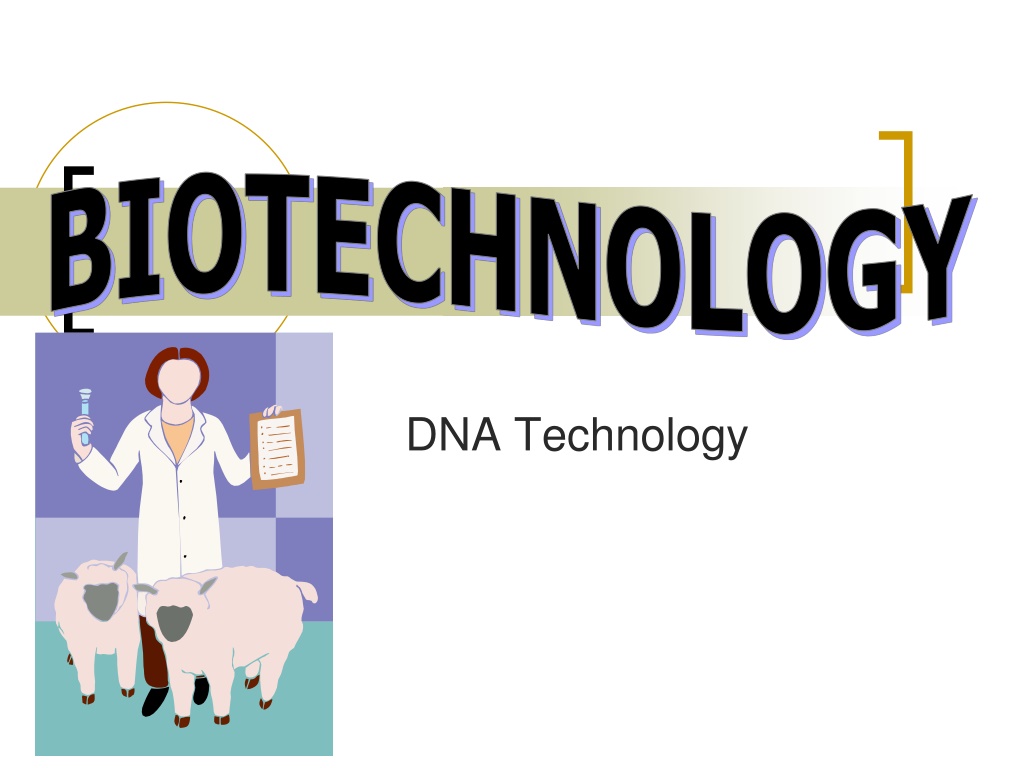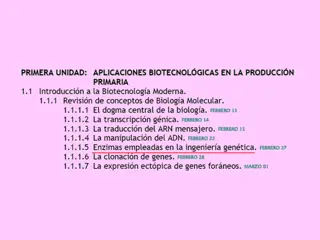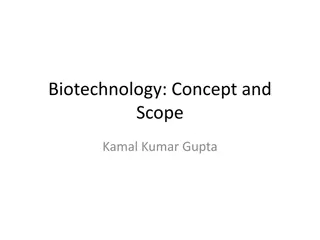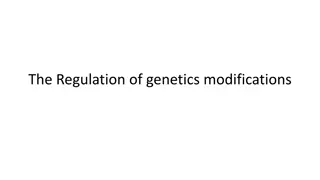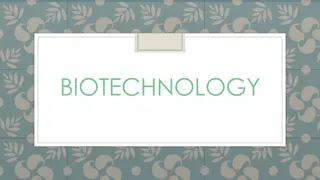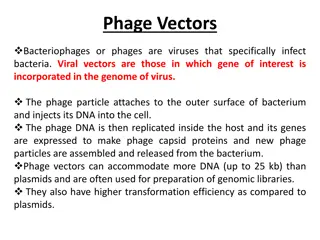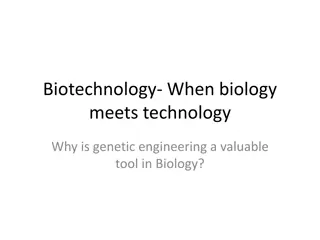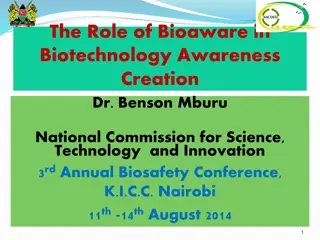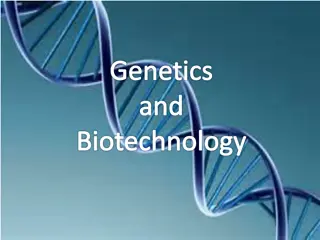Understanding Biotechnology: From Ancient Techniques to Modern Genetic Engineering
Biotechnology is the study of utilizing tools from living organisms to develop new products and processes for the benefit of society. It encompasses ancient practices like fermentation to modern genetic engineering techniques, such as manipulating genetic information in organisms. The Human Genome Project and genetic engineering play crucial roles in unlocking the potential of biotechnology, allowing for advancements in medicine, agriculture, and bioengineering.
Download Presentation

Please find below an Image/Link to download the presentation.
The content on the website is provided AS IS for your information and personal use only. It may not be sold, licensed, or shared on other websites without obtaining consent from the author. Download presentation by click this link. If you encounter any issues during the download, it is possible that the publisher has removed the file from their server.
E N D
Presentation Transcript
BIOTECHNOLOGY DNA Technology
What is biotechnology? Biotechnology = bios (life) + logos (study of) Literally the study of tools from living things
What is biotechnology? Biotechnology: is the process of harnessing 'nature's own' biochemical tools to make possible new products and processes solutions to society's ills and provide
What is biotechnology? Using scientific methods with organisms to produce new products or new forms of organisms Any technique that uses living organisms or substances from those organisms or substances from those organisms to make or modify a product, to improve plants or animals, or to develop microorganisms for specific uses
Stages of Biotechnology Ancient Biotechnology early history as related to food and shelter, including domestication Classical Biotechnology built on ancient biotechnology fermentation promoted food production medicine Modern Biotechnology manipulates genetic information in organism genetic engineering
Human Genome Project (HGP) 1.) HGP = Map of all 30,000 genes on the 46 human chromosomes (1988-2003) Information has led to many advances in the fields of medicine, agriculture, bio-engineering 2.) An organism s genome is the total DNA in the nucleus of each cell
GENETIC ENGINEERING DNA TECHNOLOGY 1.) Biotechnology refers to technology used to manipulate DNA. 2.) The procedures are often referred to as genetic engineering.
GENETIC ENGINEERING DNA TECHNOLOGY 3.) DNA is the genetic material of all living organisms. All organisms use the same genetic code (A, T, C, G).
Creating Creating Recombinant DNA Recombinant DNA
RECOMBINANT DNA - Recombinant DNA refers to the DNA from the two DIFFERENT organisms. Can be used for creating transgenic organisms, gene therapy, andcloning.
RECOMBINANT DNA -Recombinant DNA technology was first used in the 1970 s with bacteria. -A plasmid is small ring of DNA in a bacterium
Making Recombinant Bacteria Making Recombinant Bacteria 1st:Remove bacterial DNA (plasmid). -Cut the Bacterial DNA with restriction enzymes Restriction enzymes were discovered in bacteria. Bacteria use them as a defense mechanism to cut up the DNA of viruses or other bacteria
Making Recombinant Bacteria Making Recombinant Bacteria Hundreds of different restriction enzymes have been isolated Each restriction enzyme or RE cuts DNA at a SPECIFIC base sequence.
MakingRecombinant Bacteria For example, EcoRI always cuts DNA at GAATTC as indicated below
The sequence GAATTC appear three time in the below strand of DNA, so it is cut into four pieces.
Fragments of DNA that has been cut with restriction enzymes have unpaired nucleotides at the ends called sticky ends. Sticky ends have complimentary bases, so they could rejoin.
Making Recombinant Bacteria Making Recombinant Bacteria 2nd : Cut the gene of interest from the organism s DNA with same restriction enzyme (RE).
Making Recombinant Bacteria Making Recombinant Bacteria 3rd: Combine the sticky ends of the two DNA pieces together with DNA ligase (enzyme) also known as gene splicing. This creates a vector = a DNA molecule used to carry a gene of interest from one organism to another.
Plasmids & viruses are the most commonly used vectors
Making Recombinant Bacteria Making Recombinant Bacteria a.) Insert vector into bacteria. b.) The bacteria can now reproduce the recombinant DNA. c.) The foreign genes will be expressed in the bacteria.
Benefits of Recombinant Bacteria Bacteria can make human insulin or human growth hormone.
Benefits of Recombinant Bacteria Bacteria can be engineered to eat oil spills.
Plasmids Small circular DNA molecules that can reside in cells. Often contain genes fro resistance to antibiotics. They can spread antibiotic resistance They are also used for human benefit.
Genetic Engineering Possible because of special enzymes that cut DNA These enzymes are called RESTRICTION ENZYMES
DNA Scissors: An Introduction to Restriction Enzymes Restriction enzymes, are proteins that recognize and bind to specific DNA sequences and cut the DNA at or near the recognition site. A nuclease is any enzyme that cuts the phosphodiester bonds of the DNA backbone, and an endonuclease is an enzyme that cuts some where within a DNA molecule.
Restriction enzymes were originally discovered through their ability to break down, or restrict, foreign DNA. can distinguish between the DNA normally present in the cell and foreign DNA, such as infecting bacteria virus DNA The enzymes defend the cell from invasion by cutting the foreign DNA into pieces, rendering the DNA nonfunctional. Restriction enzymes appear to be made exclusively by prokaryotes.
Restriction enzymes generally recognize specific DNA sequences of 4 to 6 base pairs. These recognition sites are a palindrome in that the 5 3' base sequence is the same on both strands. Most of the enzymes make a cut in the phosphodiester backbone of DNA at a specific position within the recognition site, resulting in a break in the DNA.
These recognition cleave sites are called restriction sites.
Restriction Enzymes Recognize and cut at specific places along the DNA molecule called restriction sites. Each different restriction enzyme has its own type of site. Restriction site is a 4 or 6 base pair sequence that is a palindrome. A DNA palidrome is a sequence in which the top strand read from left to right is the same as the bottom strand read from right to left.
